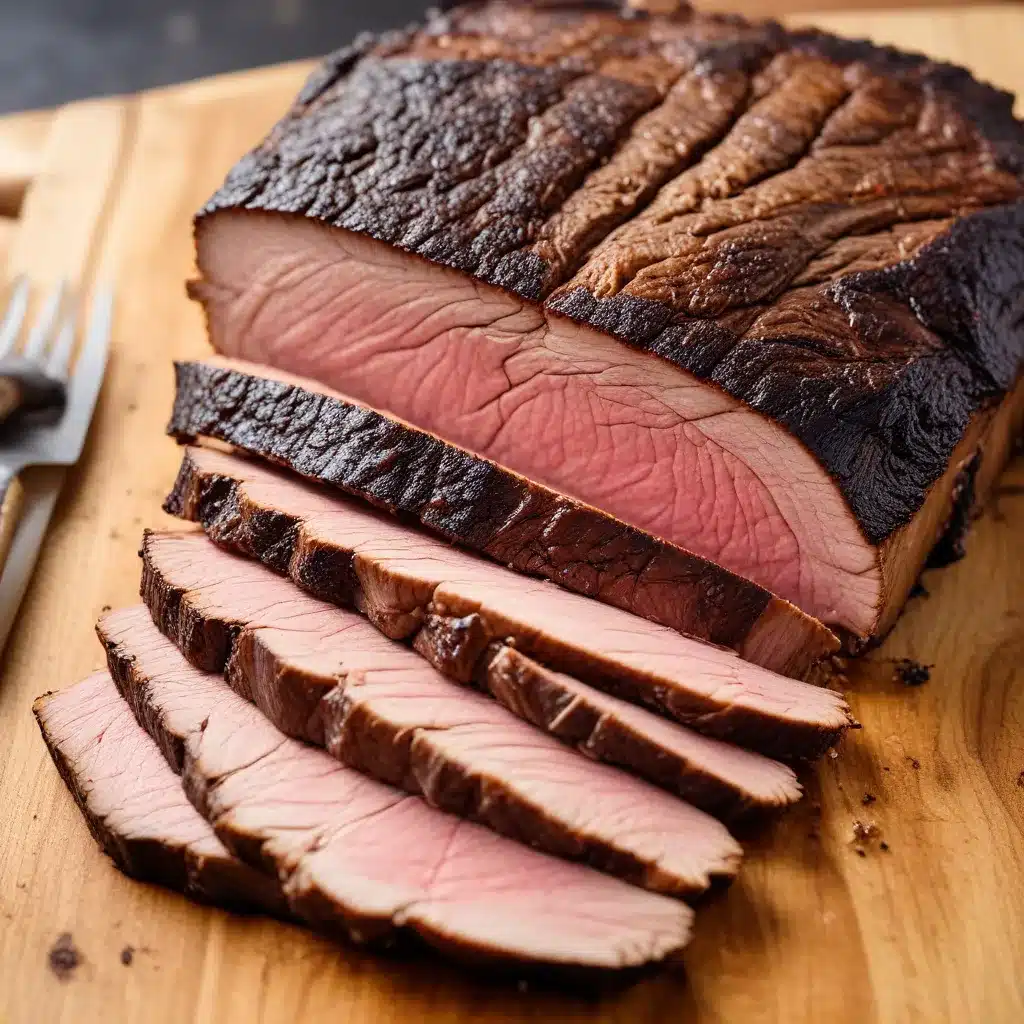
The Brisket Journey: Selecting the Right Cut
As a seasoned pitmaster, I’ve spent countless hours perfecting the art of barbecue brisket. It’s a laborious process, but the end result – a tender, juicy, and flavorful piece of meat that quite literally melts in your mouth – is truly a culinary triumph. So, let’s dive into the secrets of mastering this noble cut.
The brisket journey begins with selecting the right piece of meat. This large, tough cut from the chest or lower neck of the cattle has two distinct sections: the point and the flat. The point is fattier and often used for succulent burnt ends, while the flat is leaner but equally delicious when cooked properly. When purchasing a brisket, you’ll often come across the term “packer cut,” which refers to the entire brisket, including both the point and the flat.
Regarding the grade of the meat, higher-quality cuts like Prime or Wagyu possess more marbling, which translates to enhanced flavor and tenderness. However, a Choice-grade brisket can also yield excellent results with a bit of extra care and attention during the cooking process. When selecting your brisket, look for one with good marbling and a thick, even flat to ensure a juicy and satisfying outcome.
The size of the brisket you choose will depend on the number of people you plan to serve. A whole packer brisket can range from 10 to 15 pounds, making it perfect for feeding a crowd. If you’re cooking for a smaller group, you might opt for just the flat or the point cut. No matter which route you take, be sure to explore the wide variety of Australian BBQ Rubs & Sauces to find the perfect accompaniments for your brisket adventure.
Preparation: The Foundation for Perfection
Proper preparation is the cornerstone of a delicious barbecue brisket. From trimming the fat to applying a savory rub, each step lays the foundation for a successful smoking process.
Trimming the brisket is a crucial step, as it helps render the fat and achieve a good bark (the flavorful, crispy outer layer). You’ll want to trim most of the larger fat deposits off the meat, leaving at least a quarter-inch of fat on the brisket to help moisten the meat during cooking. If the fat is hard, remove as much as you can without affecting the meat. If it’s soft, leave it in place.
The rub you choose will significantly impact the flavor profile of your brisket. You can experiment with different rubs to find the one that suits your taste buds. Apply the rub liberally, ensuring every part of the brisket is well-seasoned. This will create a delectable crust that adds depth and complexity to the overall dish.
The Smoking Process: Patience and Precision
The heart of barbecue brisket lies in the smoking process. Achieving that tender, flavorful result requires patience and the right techniques. Let’s break down the steps to smoke your brisket to perfection.
Maintaining a consistent low temperature is key for smoking brisket. Set up your smoker to maintain a temperature around 225°F using indirect heat. The type of wood you use also influences the flavor. Common choices are oak and mesquite, with oak providing a milder flavor and mesquite a bolder, smokier profile. Ensure your smoker is up to temperature before placing the brisket inside to avoid temperature fluctuations.
During the smoking process, you might encounter a period where the temperature of the brisket plateaus, known as the “stall.” This is a normal occurrence and can last several hours. Wrapping the brisket in foil or butcher paper can help retain moisture and overcome the stall.
Overcoming Challenges: Maintaining Moisture and Texture
Smoking a brisket can present certain challenges, especially for beginners. Ensuring your brisket remains moist throughout the long smoking process is crucial. Some barbecue enthusiasts use a water pan in the smoker to maintain humidity, while others prefer injecting the brisket with broth or using a spritz bottle to keep it moist. A simple apple cider vinegar spritz every hour can help keep the brisket moist and add a hint of flavor.
Achieving a good bark is another important aspect of a well-smoked brisket. This is accomplished through a combination of the rub used, the smoke, and maintaining a dry surface on the meat. Experiment with different rub formulations and smoking techniques to find the perfect balance that results in a flavorful, crispy bark.
Slice, Serve, and Savor: Elevating the Brisket Experience
Once your brisket has reached tender perfection, it’s time to serve it up in style. How you slice and present your brisket can significantly impact the dining experience. Slicing against the grain is crucial, as it results in tender, easy-to-chew slices. It’s advisable to separate the point and the flat before slicing to ensure you’re always cutting against the grain. Use a sharp, long slicing knife for the best results.
Slicing your brisket in front of your guests can add a dramatic flair to the barbecue feast. Complement your brisket with classic sides like coleslaw, baked beans, and cornbread. A variety of sauces, ranging from spicy to sweet, can also elevate the taste. Don’t forget to offer a selection of refreshing beverages to wash it all down.
Embracing the Brisket Journey
Mastering barbecue brisket may seem daunting, but with the right guidance and a sprinkle of patience, you’re well on your way to barbecue brilliance. The journey from selecting the right cut of meat, preparing, smoking, and finally serving your brisket is a rewarding experience that not only fills the belly but also the heart.
Remember, every BBQ master was once a beginner. So, light up that smoker, put on your pitmaster hat, and let the barbecue adventures begin. Discover more recipes and articles to continue your journey with Creekside BBQ, where we’re passionate about sharing the secrets to mouthwatering perfection.

